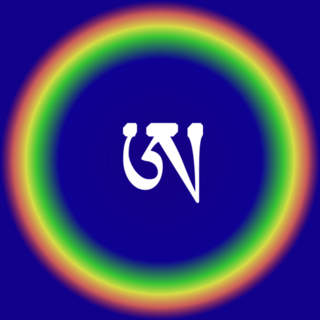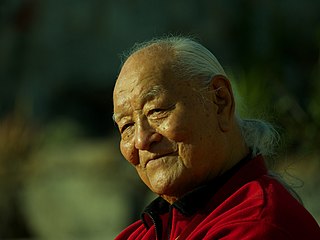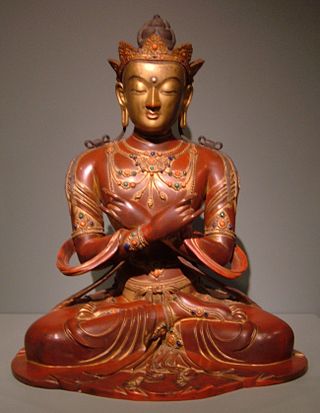
Dzogchen, also known as atiyoga, is a tradition of teachings in Indo-Tibetan Buddhism and Yungdrung Bon aimed at discovering and continuing in the ultimate ground of existence. The primordial ground is said to have the qualities of purity, spontaneity and compassion. The goal of Dzogchen is knowledge of this basis, this knowledge is called rigpa. There are numerous spiritual practices taught in the various Dzogchen systems for awakening rigpa.
The dharmakāya is one of the three bodies (trikāya) of a buddha in Mahāyāna Buddhism. The dharmakāya constitutes the unmanifested, "inconceivable" (acintya) aspect of a buddha out of which buddhas arise and to which they return after their dissolution. Buddhas are manifestations of the dharmakāya called the nirmāṇakāya, "transformation body".

In Dzogchen, rigpa is knowledge of the ground. The opposite of rigpa is ma rigpa. A practitioner who has attained the state of rigpa and is able to rest there continuously is called a Rigdzin or Rigma, which may be used as a title either pre- or post-nominally.

Namkhai Norbu was a Tibetan Buddhist master of Dzogchen and a professor of Tibetan and Mongolian language and literature at Naples Eastern University. He was a leading authority on Tibetan culture, particularly in the fields of history, literature, traditional religions, and Traditional Tibetan medicine, having written numerous books and scholarly articles on these subjects.

Vajradhara is the ultimate primordial Buddha, or Adi-Buddha, according to the Sakya, Gelug and Kagyu schools of Tibetan Buddhism. It is also a name of Indra, because "Vajra" means diamond, as well as the thunderbolt, or anything hard more generally.

In Vajrayana Buddhism, the Ādi-Buddha is the "First Buddha" or the "Primordial Buddha". Another common term for this figure is Dharmakāya Buddha.
Semde (Tibetan: སེམས་སྡེ, Wylie: sems sde; Sanskrit: cittavarga, "mind division", "mind class" or "mind series" is the name of one of three scriptural and lineage divisions within the Dzogchen tradition. The Nyingma school of Tibetan Buddhism traditionally classifies its Dzogchen teaching into three main divisions: Semde, Longdé and Menngagde.

The Kulayarāja Tantra is a Buddhist Tantra in the Tibetan language and the principal Mind Series text of the Dzogchen tradition of the Nyingma school. The Kunjed Gyalpo contains within it smaller Dzogchen texts such as the Cuckoo of Rigpa which appears in the thirty first chapter, as such it appears to be a sort of compilation of earlier Dzogchen literature .

Ekajaṭī or Ekajaṭā, also known as Māhacīnatārā, is one of the 21 Taras. Ekajati is one of the most powerful and fierce protectors of Vajrayana Buddhist mythology. According to Tibetan legends, her right eye was pierced by the tantric master Padmasambhava so that she could much more effectively help him subjugate Tibetan demons.
Dharmadhatu is the 'dimension', 'realm' or 'sphere' (dhātu) of the Dharma or Absolute Reality.

The Gankyil or "wheel of joy" is a symbol and ritual tool used in Tibetan and East Asian Buddhism. It is composed of three swirling and interconnected blades. The traditional spinning direction is clockwise, but the counter-clockwise ones are also common.
Svabhava literally means "own-being" or "own-becoming". It is the intrinsic nature, essential nature or essence of beings.
In Dzogchen, rainbow body (Tibetan: འཇའ་ལུས་, Wylie: 'ja' lus, Jalü or Jalus) is a level of realization. This may or may not be accompanied by the 'rainbow body phenomenon'. The rainbow body phenomenon is pre-Buddhist in origin, and is a topic which has been treated fairly seriously in Tibet for centuries past and into the modern era. Other Vajrayana teachings also mention rainbow body phenomena which occurs during or after the death process.

Dream yoga or milam —the Yoga of the Dream State—is a suite of advanced tantric sadhana of the entwined Mantrayana lineages of Dzogchen. Dream yoga consists of tantric processes and techniques within the trance Bardos of Dream and Sleep Six Dharmas of Naropa. In the tradition of the tantra, the dream yoga method is usually passed on by a qualified teacher to his/her students after necessary initiation. Various Tibetan lamas are unanimous that it is more of a passing of an enlightened experience rather than any textual information.
Vima Nyingthig, "Seminal Heart of Vimalamitra", in Tibetan Buddhism is one of the two "seminal heart" collections of the menngagde cycle Dzogchen, the other one being "Seminal Heart of the Dakini". Traditionally the teachings are ascribed to Vimalamitra, but they were codified and collated by their Tibetan discoverers in the 11th and 12th century. The main discoverer of the Vima Nyingthig was Zhangtön Tashi Dorjé.

The Seventeen Tantras of the Esoteric Instruction Series or the Seventeen Tantras of the Ancients are an important collection of tantras in the Nyingma school of Tibetan Buddhism. They comprise the core scriptures of the "esoteric instruction series" (Menngagde) of Dzogchen teachings and are its most authoritative scriptures.
The Mirror of the Heart of Vajrasattva is numbered amongst the Seventeen Tantras of Menngagde within Dzogchen discourse and is part of the textual support for the Vima Nyingtik.
The Mirror of the Mind of Samantabhadra is one of the Seventeen tantras of Dzogchen Upadesha.

In Dzogchen, the ground or base is the primordial state. It is an essential component of the Dzogchen tradition for both the Bon tradition and the Nyingma school of Tibetan Buddhism. Knowledge of this ground is called rigpa.

Dzogchen practice refers to the various contemplative practices which are part of the Tibetan Buddhist traditions of Dzogchen. Dzogchen contemplation or meditation relies on having the proper Dzogchen view, which, according to Tibetan Dzogchen teacher Namkhai Norbu, is not an intellectual view, but a "direct, non-dual, non-conceptual knowledge" of fundamentally pure absolute nature which has become veiled by dualistic conditioning. In Dzogchen, one achieves this view through one's relationship with a guru or lama who introduces one to our own primordial state and provides instruction on how to practice. This "direct introduction" and transmission from a Dzogchen master is considered absolutely essential.













